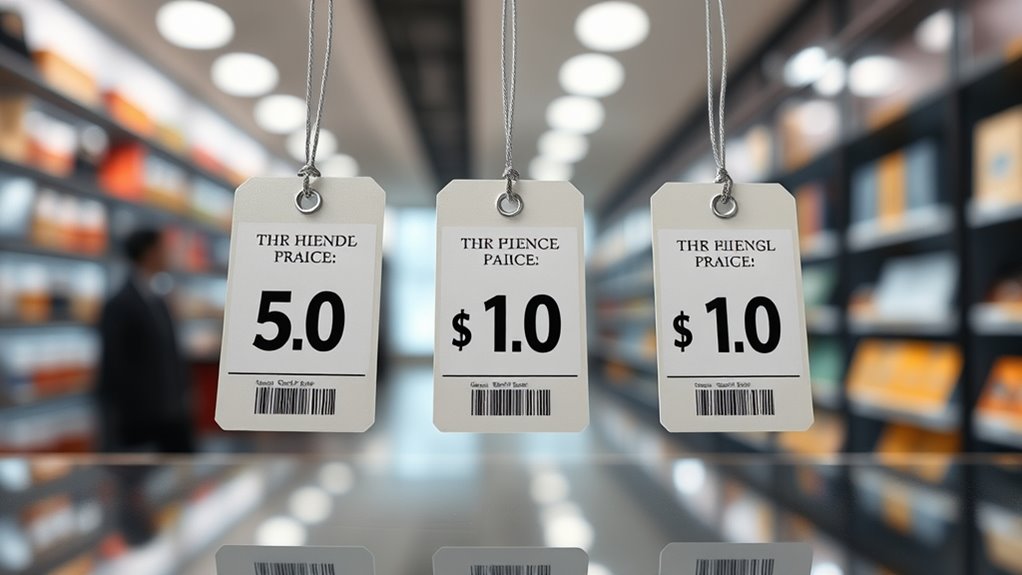Price anchoring is a retail psychology trick that influences how you perceive value by setting strategic reference points. Retailers often display high initial prices or multiple options to make other prices seem more affordable or reasonable. They may use decoy products or highlight discounts to guide your choices subtly. Recognizing these tactics helps you make smarter decisions, and if you keep exploring, you’ll uncover ways to spot these strategies in action.
Key Takeaways
- Introducing high-priced items first establishes an anchor, making subsequent options seem more affordable.
- Decoy products steer choices toward higher-margin or more desirable options through strategic pricing.
- Positioning luxury or premium items early influences perceptions of value and quality for other products.
- Using crossed-out original prices or suggested retail prices creates reference points that enhance perceived discounts.
- Awareness of pricing tactics like anchors and decoys helps consumers make more informed, ethical purchasing decisions.
The Science Behind Price Anchoring
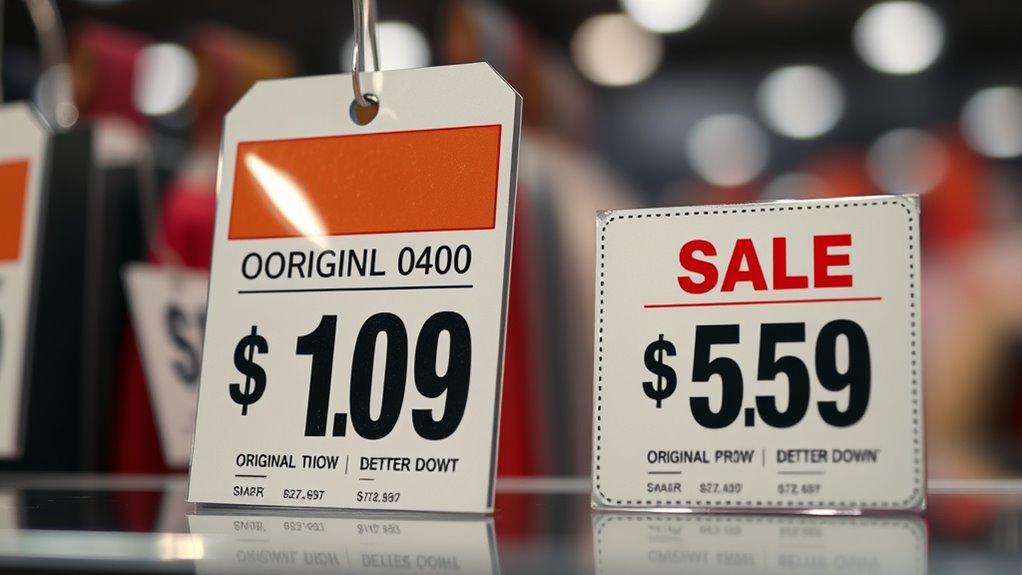
Have you ever wondered why a high initial price makes subsequent prices seem more reasonable? It’s because your brain uses that first number as a reference point, a mental anchor. When you see a luxury watch priced at $5,000, your mind perceives other options as more affordable, even if they’re still expensive. This effect is rooted in cognitive bias—your brain’s way of simplifying decision-making. Researchers have shown that once you’ve seen a high anchor, your evaluation of subsequent prices shifts, often making discounts or lower prices seem like bargains. This mental shortcut helps you feel more comfortable with your choices, even if you’re still spending a lot. Price perception also involves subconscious influences that guide purchasing behavior without conscious awareness. Price anchoring taps into your subconscious, steering your perception of value without you even realizing it. Additionally, contrast ratio plays a significant role in how vivid and striking the images appear, further influencing perceived value and quality in various purchasing decisions. In the realm of retail psychology, understanding how perceived value is shaped by initial impressions can be a powerful tool for influencing consumer behavior. Moreover, awareness of visual contrast can enhance how effectively a product or offer captures attention and influences perceptions of quality.
How Retailers Set Effective Price Anchors
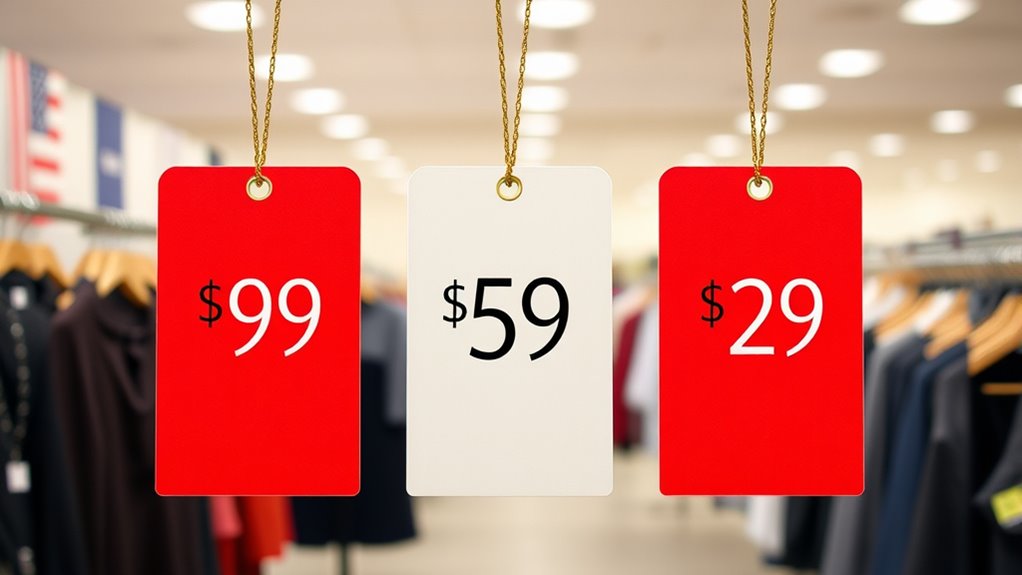
Retailers craft effective price anchors by strategically setting initial prices that influence how you perceive subsequent options. They often introduce a high-priced item first, making other products seem more affordable in comparison. For example, placing a luxury watch at a steep price makes mid-range watches appear like bargains. Retailers also use reference prices, such as the original price crossed out or a suggested retail price, to suggest a deal when discounts are applied. Additionally, they position premium products next to standard options to make the latter seem like better value. Sometimes, retailers create a sense of scarcity or urgency, making higher-priced items seem like limited opportunities worth considering. These tactics subtly shape your perception, guiding you toward decisions that benefit their sales. Incorporating content relevance and authority enhances the persuasive power of these strategies, making them more effective in influencing consumer behavior. Understanding the importance of skincare patches in product presentation can further strengthen these psychological techniques by emphasizing product value and efficacy, especially since Pimple Patches are popular for targeted acne treatment. Moreover, utilizing home decor principles like aesthetic wall organization can make product displays more appealing, subtly reinforcing perceived value. Recognizing how psychological tricks operate can help consumers make more informed choices and avoid being overly influenced by price anchoring tactics.
Common Price Anchoring Strategies in Stores

Retailers often use premium pricing to make other options seem more affordable or attractive. You’ll also notice how decoy products are placed to steer your choices toward higher-margin items. These strategies work together to influence your perception of value and guide your purchasing decisions. Additionally, understanding grocery savings strategies can help consumers recognize when stores are using certain pricing tricks to encourage higher spending. Implementing hackathons in retail environments could foster innovative ways to optimize pricing displays and customer engagement. Recognizing small mistakes in pricing presentation can prevent revenue loss and enhance customer trust. Moreover, integrating seasonal influences into pricing strategies can further sway consumer behavior by aligning discounts and offers with current trends. Recognizing the importance of personality types in consumer behavior can also help retailers tailor their pricing tactics more effectively.
Premium Pricing Tactics
Premium pricing tactics often rely on strategic price anchoring to influence customer perceptions. When you see a luxury product priced markedly higher than standard options, it sets a high anchor that makes other items seem more affordable. This technique encourages you to view the less expensive options as better deals, even if they’re still costly. Retailers use premium pricing to create a perception of exclusivity and quality, convincing you that higher prices reflect superior craftsmanship or prestige. By positioning a product as a premium choice, stores tap into your desire for status and quality, making you more likely to choose it over lower-priced alternatives. This method effectively guides your purchasing decisions, leveraging the power of high price anchors to boost sales of their most profitable items. Additionally, perception management plays a crucial role in how consumers interpret value based on pricing cues. Incorporating brand reputation into pricing strategies further enhances the effectiveness of price anchoring, as consumers often associate higher prices with greater reliability and excellence. Understanding size restrictions for tiny houses can also help retailers set optimal prices by aligning products with consumer expectations and legal standards. Moreover, recognizing psychological pricing techniques enables consumers to make more informed choices and avoid being overly influenced by pricing strategies.
Decoy Product Placement
Decoy product placement is a common strategy that leverages price anchoring to influence your purchasing choices. Retailers intentionally position a higher-priced item nearby to make other options seem more reasonable. This tactic nudges you to pick the middle or lower-priced product, feeling like a smarter choice. Here’s how it works:
| Product Option | Price | Perceived Value |
|---|---|---|
| Basic Package | $10 | Affordable, simple |
| Decoy Product | $25 | Overpriced, less appealing |
| Premium Package | $20 | Best value, balanced |
This setup makes the $20 option look like a better deal compared to the $25 decoy, guiding you toward a purchase that benefits the retailer. Understanding price anchoring techniques helps consumers make more informed decisions during shopping. Recognizing how cognitive biases influence decision-making can empower shoppers to avoid unnecessary spending. Being aware of retail psychology strategies enables consumers to critically evaluate product options and avoid being manipulated by such tactics.
The Role of Perceived Value in Price Anchoring
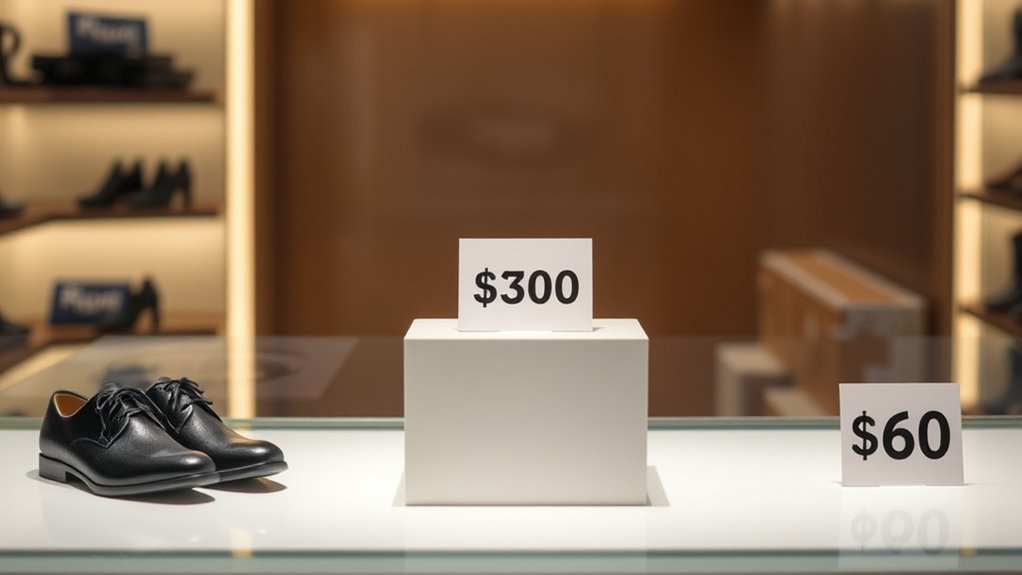
Perceived value plays a crucial role in how effectively price anchoring influences your decisions. When you see a high-priced item next to a more affordable option, your mind compares their values, making the cheaper item seem like a better deal. The initial anchor shapes your perception of worth, so even if the actual quality isn’t different, your perception changes based on the context. If a retailer positions a luxury product first, you’re more likely to see subsequent options as reasonably priced. Your perception of value isn’t solely based on the product itself but also on how it’s presented. By setting a high anchor, sellers influence how you judge the subsequent prices, often making you feel like you’re getting more for less than you originally thought.
Psychological Effects of Anchoring on Buyers
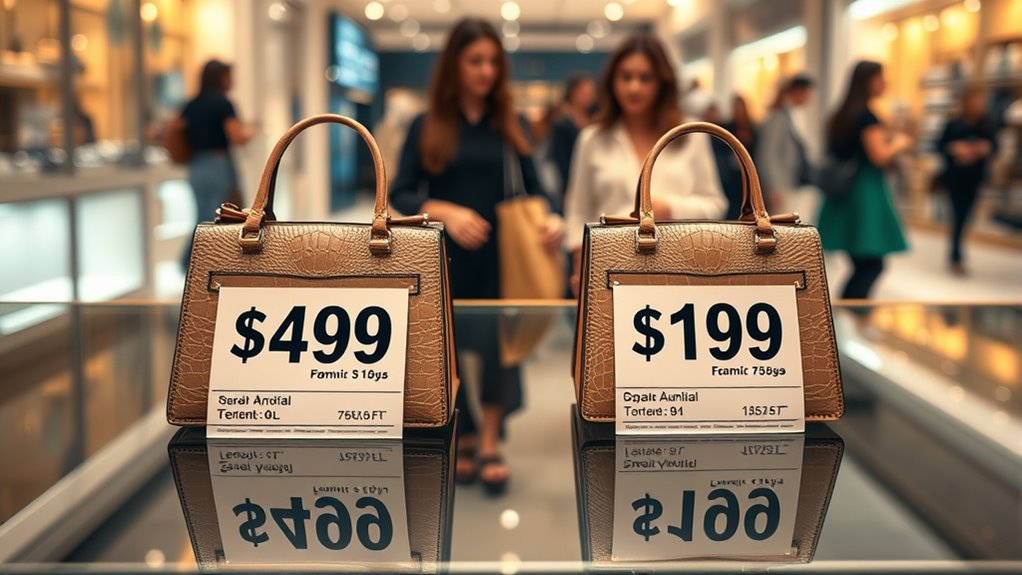
When you see a high initial price, it shifts your perception of a product’s value, making subsequent prices seem more reasonable. This anchoring shapes your expectations about what a fair price should be, influencing how you decide to buy. Ultimately, these psychological effects guide your decision-making, often leading you to accept or reject offers based on the anchored reference point.
Perceived Value Shift
Have you ever noticed how a high initial price can make subsequent options seem more affordable? That’s the Perceived Value Shift at work. When you see a luxury item priced sky-high, your mind adjusts what you consider reasonable for similar products. A mid-range option then appears more attractive because it feels like a better deal compared to the initial high anchor. This shift tricks you into perceiving greater value in the lower-priced item, even if it’s still premium. Retailers leverage this by setting a high anchor first, making other options seem like smarter choices. Your perception of worth is fluid, heavily influenced by the initial reference point, leading you to believe you’re getting a better deal than you actually are.
Price Expectations Formation
Price expectations form quickly in your mind, often influenced by the initial prices you encounter. When you see a high sticker price, your mind tends to set a higher baseline for what’s reasonable, even if you later find discounts. Conversely, a low starting price can set your expectations low, making a subsequent price seem more expensive. These initial numbers act as anchors, shaping how you perceive value and affordability. Your brain compares subsequent prices to these anchors, which can distort your judgment. If the first price you see is high, you might accept a higher price later, thinking it’s a good deal. If it’s low, you may feel disappointed or skeptical when prices rise. This formation of expectations happens quickly, often without your conscious awareness.
Decision-Making Influence
Your initial price expectations don’t just shape what you think is fair; they also influence your purchasing decisions in subtle yet powerful ways. When anchored to a high or low price, your mind naturally gravitates toward that figure, affecting how you evaluate deals. This influence can lead you to accept a higher price as reasonable or dismiss a good deal if it deviates from the anchor. It also impacts your perception of value and urgency. For example:
- You may perceive a discounted item as a better deal if it’s compared to a higher original price.
- Your willingness to pay increases when the initial anchor is high.
- You might overlook better options if they don’t align with the anchored price.
- Anchors shape your expectations, guiding your buying behavior without you realizing it.
Real-World Examples of Price Anchoring
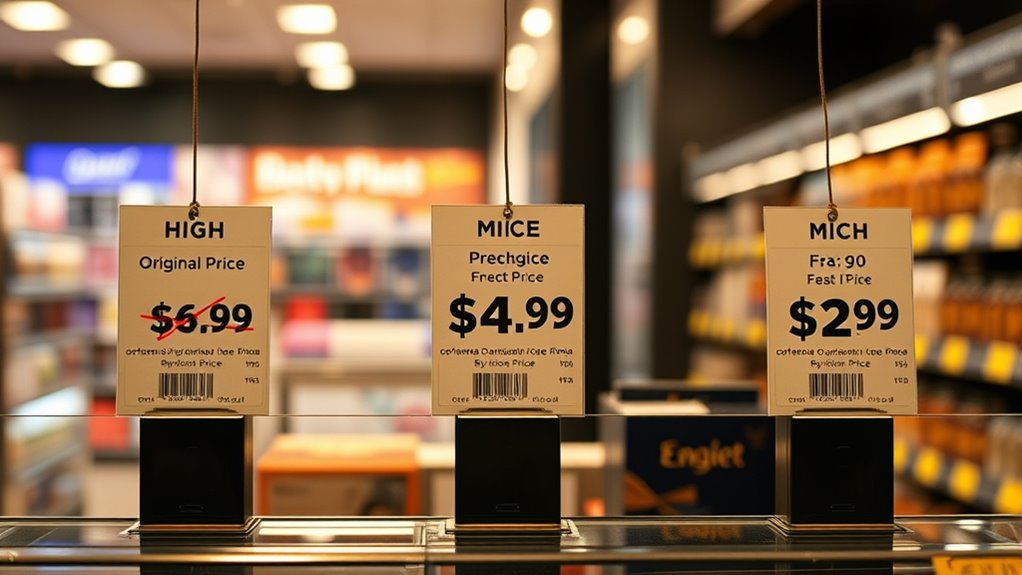
One common example of price anchoring appears in retail stores, where high-priced items are placed alongside more affordable options to make the latter seem like a better deal. For instance, luxury watches are often displayed next to moderately priced models, prompting you to perceive the middle option as more reasonable. This tactic influences your buying decision by establishing a reference point. Here’s a quick look:
| High-Priced Item | Middle Option |
|---|---|
| $5,000 | $2,000 |
| Ultra-luxury | Premium |
| Influences your perception of value | Makes the middle seem affordable |
How Consumers Can Recognize Price Anchors
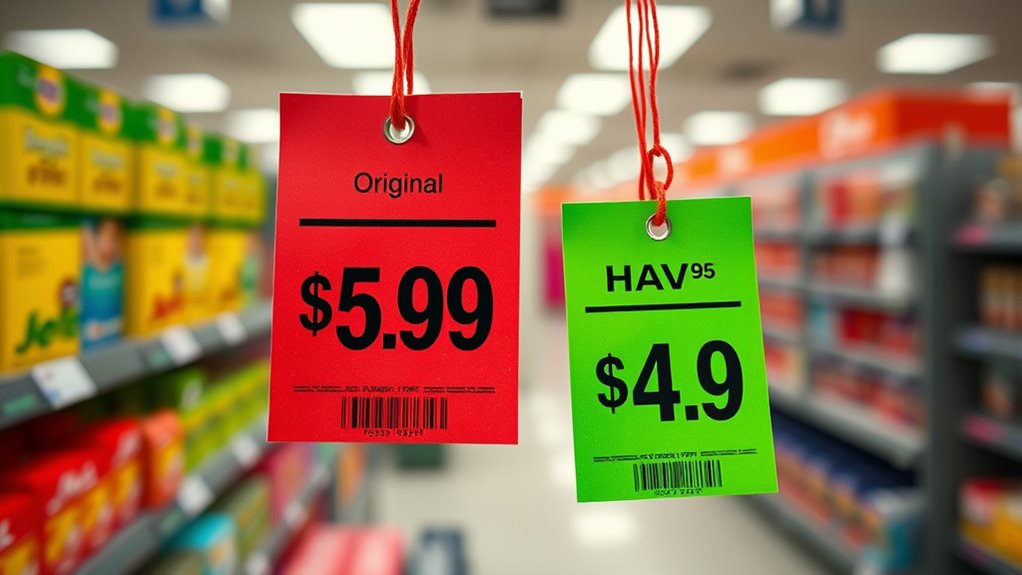
Have you ever wondered how to spot when a retailer is using price anchoring to influence your choices? Recognizing these tactics helps you make smarter decisions. Look for the original high price listed next to a discounted item—it’s often an anchor. Notice if a store displays a premium product next to standard options, making the latter seem more affordable. Pay attention to limited-time offers that highlight significant discounts from a higher initial price. Also, be wary of “compare at” prices that suggest a deal but may be inflated. To stay alert, ask yourself whether the original price seems realistic or inflated. Being aware of these cues allows you to evaluate whether a deal is genuine or just a psychological trick.
Ethical Considerations and Consumer Awareness
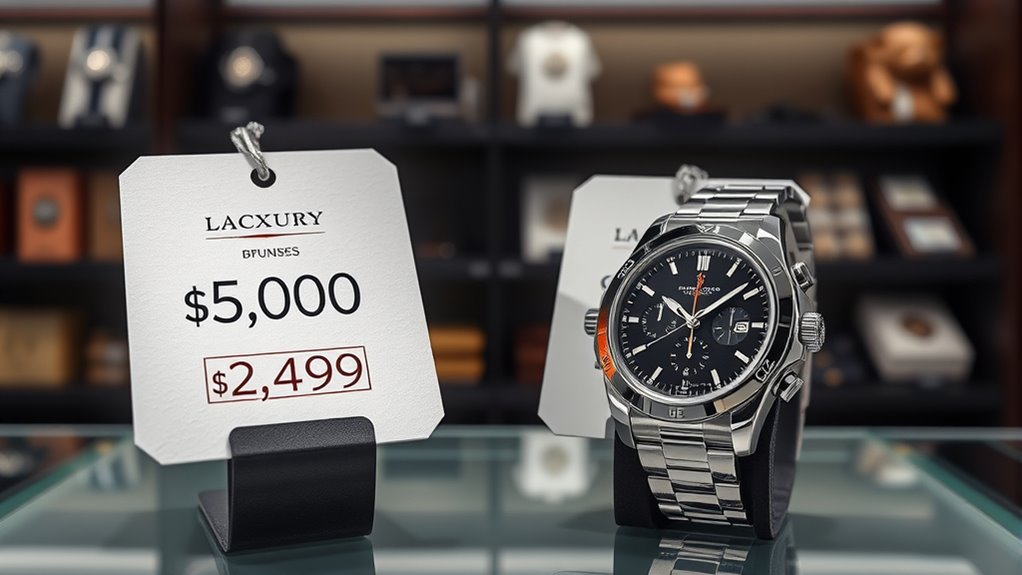
Recognizing price anchoring tactics is the first step toward making ethical and informed purchasing decisions. It’s essential to remain aware of how retailers use these strategies to influence your perception of value. By understanding that anchoring often involves presenting a high initial price to make subsequent offers seem more attractive, you can better evaluate whether you’re genuinely getting a good deal. Ethical shopping encourages transparency and honesty from sellers, but not all practices align with these values. As a consumer, you should question pricing patterns and seek clarity on discounts and comparisons. Staying informed helps you avoid being manipulated and promotes fairer market practices. Ultimately, awareness empowers you to make choices that reflect your true needs rather than falling prey to marketing tricks.
Frequently Asked Questions
How Can Consumers Avoid Falling for Price Anchoring Tactics?
You can avoid falling for price anchoring tricks by being aware of how retailers set high initial prices to influence your perception. Always compare prices across different stores and look for the true value of a product. Don’t rely solely on the first price you see; do your research, set your budget, and focus on what genuinely matters to you. This way, you stay in control and make smarter purchasing decisions.
Does Price Anchoring Influence Online Shopping Decisions?
This question hits the nail on the head—price anchoring truly shapes your online shopping decisions. When you see a high original price next to a discounted one, your brain perceives a fantastic deal, even if it’s not. You might buy more expensive items or settle for less value. To dodge this, compare prices across sites, focus on actual value, and don’t let a fancy tag fool you into overspending.
Are There Differences in Price Anchoring Effectiveness Across Cultures?
You might wonder if price anchoring works differently across cultures. It does—cultural factors influence how people perceive price cues. For example, in some cultures, high initial prices set as anchors can strongly shape perceptions, while others may be less affected. You should consider local shopping behaviors and values, as these impact how effectively price anchoring guides decisions. Adjust your strategy accordingly to connect with diverse audiences.
Can Price Anchoring Backfire on Retailers?
Did you know that 65% of consumers feel misled by pricing strategies? Price anchoring can backfire if customers perceive it as manipulative, leading to distrust and damaged loyalty. You risk alienating shoppers if you consistently highlight inflated prices before discounts. Instead, focus on transparent, fair pricing to build trust. Misusing anchoring may boost short-term sales but can harm your reputation and long-term customer relationships.
How Do Seasonal or Promotional Discounts Impact Anchoring Strategies?
Seasonal or promotional discounts can notably influence your anchoring strategies by shifting customer perceptions of value. When you offer a discount, you set a new reference point, making regular prices seem less attractive. Customers might delay purchases or expect discounts regularly, which can weaken your pricing power. To avoid this, you should carefully time discounts and communicate the value clearly, ensuring your anchors remain effective and your brand maintains perceived quality.
Conclusion
Understanding price anchoring helps you spot clever retail tricks. For instance, when a store displays a $1,200 jacket next to a $600 one, the cheaper looks more affordable. Awareness lets you make smarter choices, resisting impulse buys. Next time you see a high initial price, recognize it as an anchor. Stay informed, and you’ll shop confidently—like noticing that luxury car ads often highlight a hefty sticker price to boost perceived value.
